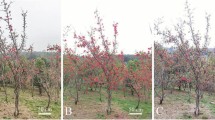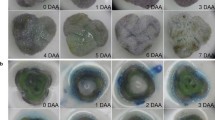Abstract
Nolana L.f. is a large, diverse genus in the Solanaceae endemic to the coastal deserts of Peru and Chile. Floral development studies were conducted in eight species (Nolana adansonii, N. aticoana, N. elegans, N. humifusa, N. ivaniana, N. laxa, N. plicata, and N. rupicola) as a precursor to breeding efforts and studies of interspecific sexual compatibility. Levels of stigma receptivity and pollen viability were evaluated at different stages during flower development. Species were found to be receptive to pollination over a wide range of floral developmental stages, including stages prior to anthesis. Pollen was found to remain viable throughout the open flower period and into senescence. Floral development keys were developed which provide a visual reference correlating morphological appearance of buds and flowers of each species at each developmental stage, and their corresponding durations and levels of stigma receptivity.



Similar content being viewed by others
References
Aleemullah M, Haigh AM, Holford P (2000) Anthesis, anther dehiscence, pistil receptivity and fruit development in the Longum group of Capsicum annuum. Aust J Expt Agric 40:755–762
Bondeson WE (1986) Gynoecial morphology and funicular germination plugs in the Nolanaceae. Nord J Bot 6:183–198
Carlquist S (1987) Wood anatomy of Nolanaceae. Aliso 11:463–471
Dafni A, Nepi M, Pacini E (2005) Pollen and stigma biology; protocol. In: Dafni A, Kevan PG, Husband BC (eds) Practical pollination biology. Enviroquest, Cambridge, Ontario, p 590
Dillon MO, Rundel PW (1989) The botanical response of the Atacama and Peruvian Desert floras to the 1982–1983 El Niño event. In: Glynn PW (ed) Global ecological consequences of the 1982–1983 El Nino-Southern Oscillation. Elsevier Oceanography Series, Amsterdam, pp 487–504
Dillon MO, Nakazawa M, Leiva S (2003) The Lomas formations of coastal Peru: composition and biogeographic history. In: Haas J, Dillon MO (eds) El Niño in Peru: biology and culture over 10,000 years. Fieldiana, Botany. N.S. 43. publ. 1524, pp 1–9
Dillon MO, Tu T, Soejima A, Yi T, Nie Z, Tye A, Wen J (2007) Phylogeny of Nolana (Nolaneae, Solanoideae, Solanaceae) as inferred from granule-bound starch synthase I (GBSSI) sequences. Taxon 56:1000–1011
Freyre R, Douglas AC, Dillon MO (2005) Artificial hybridizations in five species of Chilean Nolana (Solanaceae). HortScience 40:532–536
Knapp S (2002) Tobacco to tomatoes: a phylogenetic perspective on fruit diversity in the Solanaceae. J Exp Bot 53:2001–2022
Li SJ, Zhang DX, Li L, Chen ZY (2004) Pollination ecology of Caesalpinia crista (Leguminosae: Caesalpinioideae). Acta Bot Sin 46:271–278
Luo S, Zhang D, Renner SS (2006) Oxalis debilis in China: distribution of flower morphs, sterile pollen and polyploidy. Ann Bot 98:459–464
Mesa MA (1981) Nolanaceae. Flora Neotropica 26:1–197
Mesa MA (1986) The classification of the Nolanaceae. In: D’Arcy WG (ed) Solanaceae: biology and systematics. Columbia University Press, New York, pp 86–90
Olmstead RG, Palmer JD (1992) A chloroplast DNA phylogeny of the Solanaceae: subfamilial relationships and character evolution. Ann Mo Bot Gard 79:346–360
Rodriguez-Riano T, Dafni A (2000) A new procedure to assess pollen viability. Sex Plant Reprod 12:241–244
Royal Horticultural Society (1995) RHS colour chart. Royal Horticultural Society, London
Sapir Y, Shmida A, Me’eman G (2005) Pollination of Oncocyclus irises (Iris: Iridaceae) by night-sheltering male bees. Plant Biol 7:417–424
Saunders ER (1934) The history, origin and characters of certain interspecific hybrids in Nolana and their relation to Nolana paradoxa. J Genet 29:387–419
Stone JL, Thomson JD, Dent-Acosta SJ (1995) Assessment of pollen-viability in hand-pollination experiments: a review. Am J Bot 82:1186–1197
Tago-Nakawaza M, Dillon MO (1999) Biogeografia y evolución en el clado Nolana (Solaneae-Solanaceae). Arnaldoa 6:81–116
Tu T, Dillon MO, Sun H, Wen J (2008) Phylogeny of Nolana (Solanaceae) of the Atacama and Peruvian deserts inferred from sequences of four plastid markers and the nuclear LEAFY second intron. Mol Phylogenet Evol 49:561–573
Wang Y, Zhang D, Renner SS, Chen Z (2005) Self-pollination by sliding pollen in Caulokaempferia coenobialis (Zingiberaceae). Int J Plant Sci 166:753–759
Acknowledgments
This study was partially supported by the New Hampshire Agricultural Experiment Station and a 2006 grant from The American Floral Endowment. The authors would like to thank Dr. Michael Dillon, Field Museum, Chicago, IL and Víctor Quipuscoa, Universidad Nacional San Agustín, Arequipa, Perú for help in obtaining plant material; Drs. Paul Fisher and Tom D. Davis for helpful discussions and revisions of early versions of the manuscript; and John McLean, Evan Ford and Ryan Lockhart for greenhouse plant maintenance.
Author information
Authors and Affiliations
Corresponding author
Rights and permissions
About this article
Cite this article
Douglas, A.C., Freyre, R. Floral development, stigma receptivity and pollen viability in eight Nolana (Solanaceae) species. Euphytica 174, 105–117 (2010). https://doi.org/10.1007/s10681-010-0145-8
Received:
Accepted:
Published:
Issue Date:
DOI: https://doi.org/10.1007/s10681-010-0145-8




